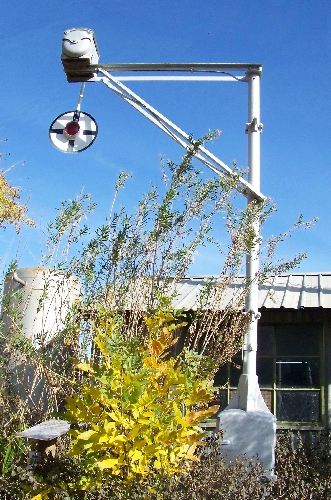Old-time urban railroads roll again in Perris, Calif.
Riding the Red Car to Los Angeles was something I relished as a kid. In the late 1940s and early '50s, the fastest public transportation from the far-flung suburbs of Los Angeles to Downtown L.A. was the Pacific Electric trolley.
When my mother had a reason to go "downtown," we would go to the El Monte bus/train station and climb aboard a Los Angeles-bound Red Car. It's hard to imagine that Los Angeles, which some now call the land of freeways, formerly had more than 1,000 miles of interurban and city streetcar tracks serving more that 42 communities.
While the expansive trolley system has been gone for nearly five decades, you can still experience the joy of riding one of those ancient trolley cars. Just visit the Orange Empire Railroad and Trolley Museum in Perris, Calif. Whether you remember riding streetcars, or you've only heard or read about them, their mystique lives on at this sprawling compound about 60 miles east of Los Angeles. If trains and railroading are more to your liking, the museum has a lot to offer you, also.
If you're in the Los Angeles or Inland Empire area on a weekend, that's the best time to visit the museum. While the grounds are open 9 a.m. to 5 p.m. weekdays often as not, there's little activity. Many of the indoor exhibits usually are shuttered on weekdays.
On weekends, the place comes alive. The trains and trolley cars are running, exhibits are open and there are usually dozens of visitors. The grounds and exhibits usually aren't crowded. On special event weekends, however, the number of visitors can shoot up into the hundreds.
Be sure to pick up a free map of the grounds at the Pinacate Station Museum Store. It also has railroad and trolley memorabilia, books, and train-related toys. And it's where you buy tickets to ride the trolleys and trains.
Two major exhibits are the Los Angeles Railway Barn and the Grizzly Flats Engine House No 6.
In the Railway Barn are some restored streetcars, and several more in various stages of restoration, that once roamed the trolley tracks of Los Angeles
You can climb aboard the static exhibit and get a sense of the trolley experience. There are leather seats, poles for standing riders to grip, high ceilings and large windows. Just above the windows are advertisements, on large cards, from the 1940s and 1950s for consumer products, radio shows and political advertisements: Sunshine Crackers, Lux Soap, the "Lone Ranger" radio show, Listerine mouthwash and an ad urging citizens to vote for Dewey and Warren in the 1948 presidential election.
There's a wall exhibit of tickets used in the 1940s. It cost $1.50 for a one week "Inner Zone" pass in 1948.
In the Grizzly Flats Railroad exhibit are meticulously restored locomotives from the early 1900s. Steam engines typically had a long service life. The Chloe, a narrow-gauge engine, was built in 1907 by the Baldwin Locomotive Works and was retired in 1948 after years of service in Hawaii, hauling sugar cane from fields to processing plant.
Another steam engine is the Emma Nevada, built by Baldwin in 1881 for the Nevada Central Railroad. It was used for almost 50 years between Battle Mountain and Austin. Ward Kimball, who was an animator for Disney Studios, bought it in 1938. It was part of his "backyard railroad" for many years. Kimball, one of the museum's founders, donated the locomotive.
There is a picnic area near the main entrance, and visitors are welcome to bring their own food. Across the street is the "signal garden." It's an interactive display of railroad devices used to signal and warn train engineers of various track conditions. There are also examples of grade crossing signals to warn drivers and others of an approaching train, including working examples of the "wigwag" type, once commonly used throughout the country.
Another reason to visit on weekends: You can ride the trolley cars and trains. On a typical weekend (other than during special events), two city streetcars are operated on the half-mile dual-gauge Loop Line. A train, usually an electric- or diesel-powered freight locomotive with a caboose or two, and a gondola car, is usually operating on the 1.5-mile standard gauge mainline. On some weekends, a Pacific Electric Red Car also plies the Mainline.
Your journey on this antique rolling stock won't be as complete or exciting as Doc Brown's 100-year leap in "Back to the Future Part III." But it will give you a taste of the past without any danger of being stranded there for any longer than a weekend.
GETTING THERE
Location: Orange Empire Railroad and Trolley Museum in Perris, Calif., about 255 miles southwest of Las Vegas.
Directions: From Las Vegas, take Interstate 15 south 214 miles; bear left to take Interstate 215 south about 37 miles, take the D Street exit. Take north D Street one mile, turn right onto west 11th Street for .3 miles, then left on south A Street about .1 mile.
Hours: 9-5 daily; trains and trolleys operate Saturdays and Sundays only.
Admission: Free, except during some special events.
Ride tickets: On regular weekends, adults $12; children 5-11 $8; under 5 ride free. Family pass $40. Tickets good all day for unlimited rides.
Further information: Many special events are held, offering opportunities such as riding steam engines, some requiring reservations. Before going, check Web site at www.oerm.org, and under "Calendar," click on "Special Events." Or call (951) 943-3020.

















